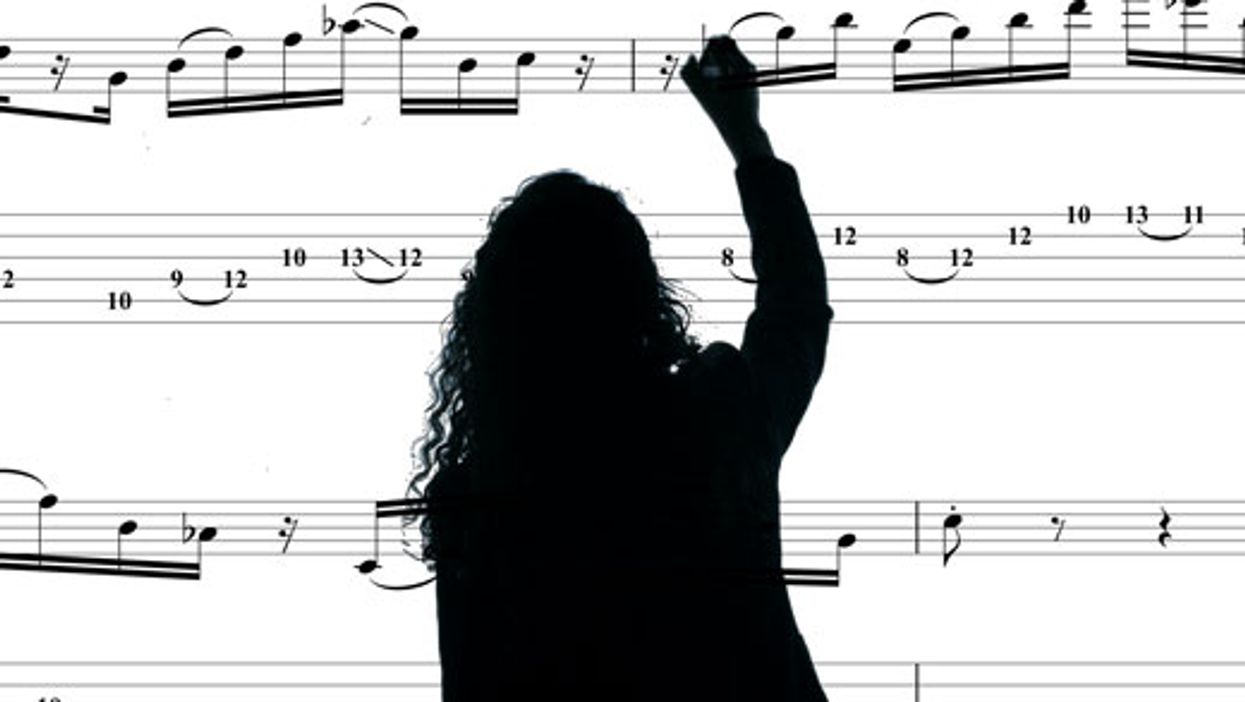Chops: Intermediate
Theory: Advanced
Lesson Overview:
• Understand the physics of three different picking styles.
• Learn how to improvise over extended chord changes.
• Develop a more fluid picking technique. Click here to download a printable PDF of this lesson's notation.
I’m just a pick, yes, I’m only a pick
So, don’t blame me when you can’t play a lick
Heavy or light, pointy or round
I’m only a very small part of your sound
In a masterclass at the University of Louisville in ’93, jazz guitarist Jimmy Raney discussed how he developed a picking technique that allowed him to phrase bebop lines similar to pianist Bud Powell and saxophonist Charlie Parker. Raney remarked that he and Tal Farlow were “the only ones doing it on guitar.” When asked to elaborate on his picking technique, Raney explained that he decided to “not think about it consciously.” Instead he would simply play the phrases until they sounded correct. Raney’s masterclass reveals two things about picking on guitar: It’s grounded on the techniques of few guitar predecessors and it’s a relatively new concept. Raney developed his picking technique intuitively by ear and subscribed to the sentiment of “listen and play” to achieve his understanding of the instrument. It’s well worth six minutes to watch the excerpt of Raney’s clinic below.
The practice of emulating other instrumentalists can serve as an intuitive means of discovering the skills necessary to execute a variety of musical ideas. For guitarists, there are a few principal picking methods used in most genres, whether jazz, rock, blues, etc. By unraveling the physical mechanisms of these techniques, you can develop an arsenal of essential skills on the instrument and, eventually, a musical style of your own. In this lesson, we will dissect three primary flatpicking techniques: alternate picking, economy picking, and hybrid picking. The harmonic concepts of this lesson are advanced and useful for jazz and fusion styles, but can also be adapted to blues, funk, and original work.
Round and Round We Go
Alternate picking is arguably the most common picking technique taught and discussed in the guitar community. It's a technique useful for lines that are evenly laid on the fretboard and require strong, staccato-like articulation. In Ex.1, I use a three-note-per-string pattern to organize the notes of the C melodic minor b5 scale (1–2–b3–4–b5–6–7), also known as Jeths’ mode (named after Dutch composer Willem Jeths). Organizing the scale this way evenly divides the upstrokes and downstrokes between strings so that you don’t have to play a different number of notes per string and change the local direction of your picking in random spots. In other words, organizing the arrangement of notes on the strings makes it easier on the picking hand to execute the line.
Click here for Ex. 1
In Ex. 2, I play a repetitive line similar to the first example, but this time the number of notes per string varies to demonstrate how alternate picking works when the notes aren’t neatly lined up on the fretboard. For this line, it's imperative to use a method called “inside picking.” In the second measure the C# must be played with an upstroke so your hand moves toward the 2nd string for the following note. If it were a downstroke, your right hand would be pointed toward the ground, not toward the 2nd string, so you’d have to cross over the extra distance of the 1st string and risk flubbing a note somewhere in the line. Alternate picking can be a powerful technique especially when combined with inside picking.
Click here for Ex. 2
Your Pick is a Feather
Alternate picking isn’t practical when playing arpeggiated ideas where there is only one note per string. In this situation, it’s common to use a sweep picking technique. In Ex. 3, small sweeps interrupt the line. To switch into sweep picking, I relax my picking hand and angle my hand toward the direction that I’m sweeping to. If the arpeggio is going toward the 1st string, I angle my hand down toward the floor. If it's going toward the 6th string, I angle my hand toward my body. The downward position is more natural to the body, so sweeping down is easier than going toward the body. It's important to stay relaxed and use gravity to your advantage. When there are two notes on a single string, use a hammer-on to make sure that the picking hand has time to prepare for the upcoming sweep.
Click here for Ex. 3
When sweeping for a long period of time, it’s important to watch how the arm and shoulder helps take the pressure off the wrist to create the sweeping motion. Endurance can make or break your execution. Allocating the energy of the motion between shoulder, arm, wrist, and even the fingers that hold the pick can significantly reduce the tension in your picking hand and help even out your time-feel and tone. In Ex. 4 I demonstrate a long sweep comprising small triadic arpeggios that climb up the neck. To make sure the right hand doesn’t flub while changing the sweep direction, I avoid playing the same note twice in succession on the same string, which means that the direction of my picking seldom changes.
Click here for Ex. 4
Save Energy Like You Save Money
Sometimes, neither alternate nor sweep picking is ideal. In Ex. 5, I play a line that requires you to pick only the first note of every 16th-note triplet, and then the one note after the triplet figure. For the first four notes in the example, use a downstroke for the C#, hammer-on the D#, pull-off for the next C#, then downstroke or upstroke for the A. This combination of hammer-ons and pull-offs is one way your picking can be “economized” so that your left hand can do more work, and the right hand can be used to control the volume and timbre of your lines.
Click here for Ex. 5
Economy picking is a powerful and adaptive technique because it allows you to combine several musical ideas into one, and it’s a perfect technique for musical tongue-twisters like Ex. 6. In this example, I double various notes in a B minor pentatonic (B–D–E–F#–A) lick so that the line twists and zigzags. Alternate picking a line like this would be a nightmare because the number of notes per string is constantly changing and there is little opportunity for inside picking. Therefore, I use as many hammer-ons and pull-offs as possible and pick only to accentuate certain areas of the line and maintain an even volume.
Also, if I have only one note per string, I make sure that my picking hand is resting on the target note before I attack it, so I’m ready to pick in whatever direction necessary. For example, in measure one, the second B note is played on the 2nd string, preceded by a B on the 1st string, and followed by a D on the 1st string. To make this as easy as possible, pull off for the first B note, downstroke the B note after it, then continue the downstroke movement to play the following D note. Easy, right? Not really, which is why economy picking is so important to take your picking to the next level.
Click here for Ex. 6
When There’s Just No Other Way
Hybrid picking is an effective technique for multiple, rapid leaps between strings. In Ex. 7, I divide the idea into groups of two, always playing the first note of each group with my pick and the second with my middle finger. Alternate picking here is impractical because you would have to constantly leap strings. Between each note in Ex. 7is a distance of one string, so rather than making those jumps you can easily prepare your middle finger to pluck the second note. Hybrid picking this line can help eliminate any tension in the right hand and achieve rapids speeds despite the leaps.
Click here for Ex. 7
We revisit this concept again in Ex. 8, but the difference this time is that we’re also using hammer-ons and open strings to demonstrate how you can create unique sonic textures with the combination of minimal picking, open strings, leaps, and wide intervals. The result is a line that sounds harp-like. The guitar is an expressive instrument indeed.
Click here for Ex. 8
Putting It All Together
The following two examples demonstrate how you can use a combination of all the techniques to improvise lines over a chord progression.
In Ex. 9, I play four measures of improvised music over a progression that’s resolving to Bm. Over the C#7(#9), the passage primarily consists of sweeps that are interrupted by quarter-notes and eighth-notes. I like to keep things simple and use downstrokes for notes that have a long duration. Using downstrokes more often can help keep your right hand in equilibrium and ready for more intricate passages. Over the F7(#5), I take a similar approach as in the first two measures.
Click here for Ex. 9
In Ex. 10, I play several lines over the first eight measures of a standard “rhythm changes” progression. The passage starts with a sweep in the pickup measure, followed by two measures of alternate picking until measure three, where I use a pull-off between the D and Db. The ideas over the Bb/D–Dbdim7 (measure three) and Cm–F7 (measure four) are all played using a pull-off in the beginning of the figure, followed by a small sweep toward the body.
When you’re at the end of each figure, like the F over the Bb/D chord in measure three, you’ll have to leap to come back up to the 2nd string and play the Dbdim7 idea. For this leap, you can again use the middle finger (or any free finger on your picking hand that feels best to you) to play the first note of the Dbdim7 figure, then pull-off for the second note. While it is possible to avoid hybrid picking and try to make the leap with just your wrist, using one of your free fingers eliminates tension by reducing movement and expended energy. In measure six, economy picking is a good choice. Measure six consists mostly sweeping with one hammer-on between the 3rd and 5th frets of the 3rd string, and measure seven wraps things up with some “economizing.”
Click here for Ex. 10
Good luck on your journey to becoming the next shred master. Just remember, technique should be informed by the music, not the other way around.
















